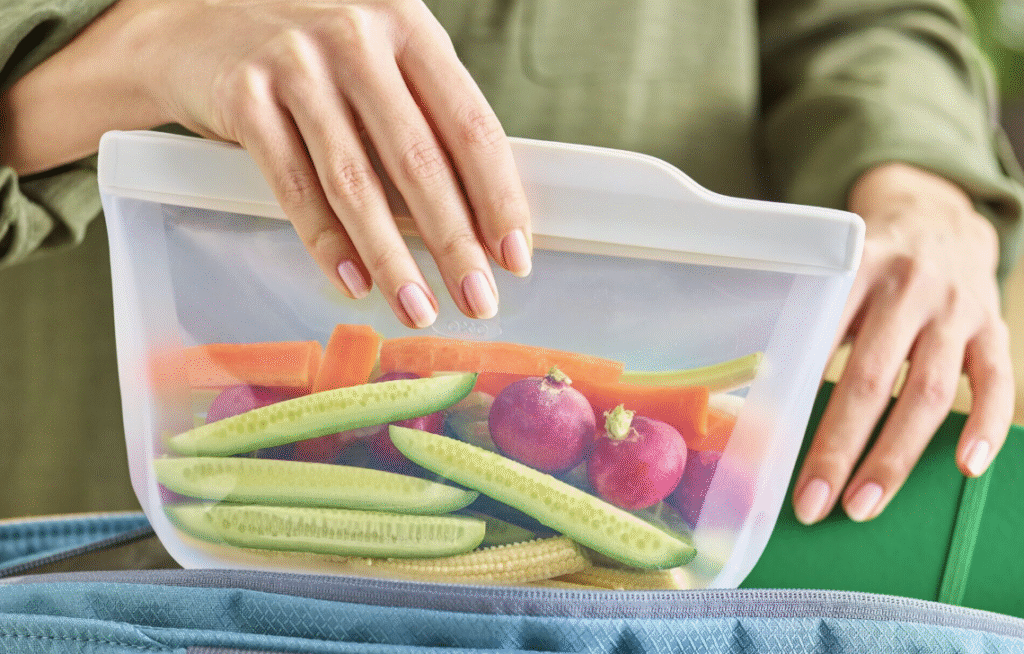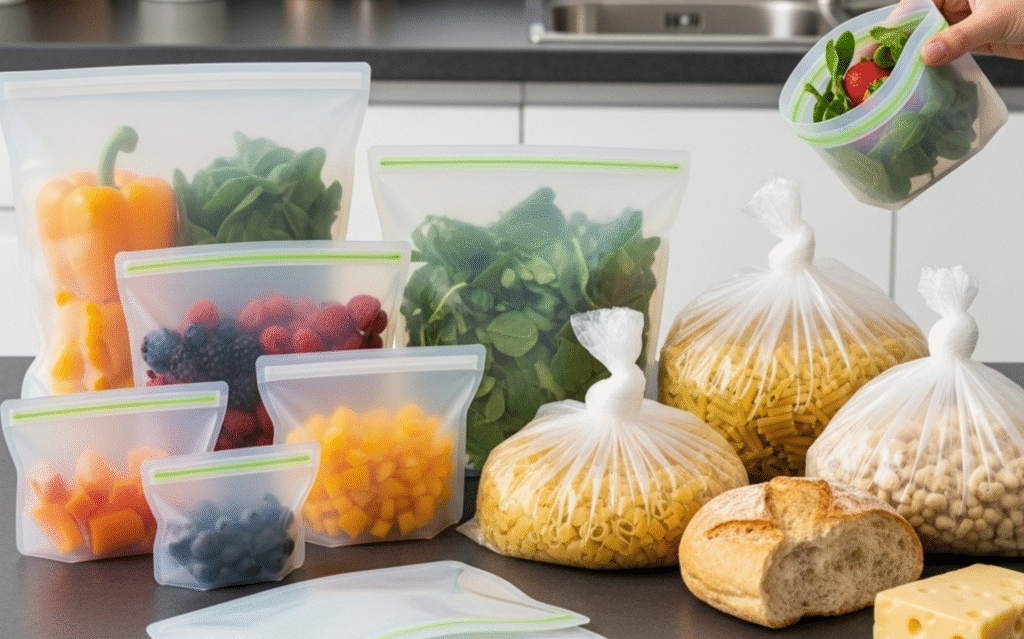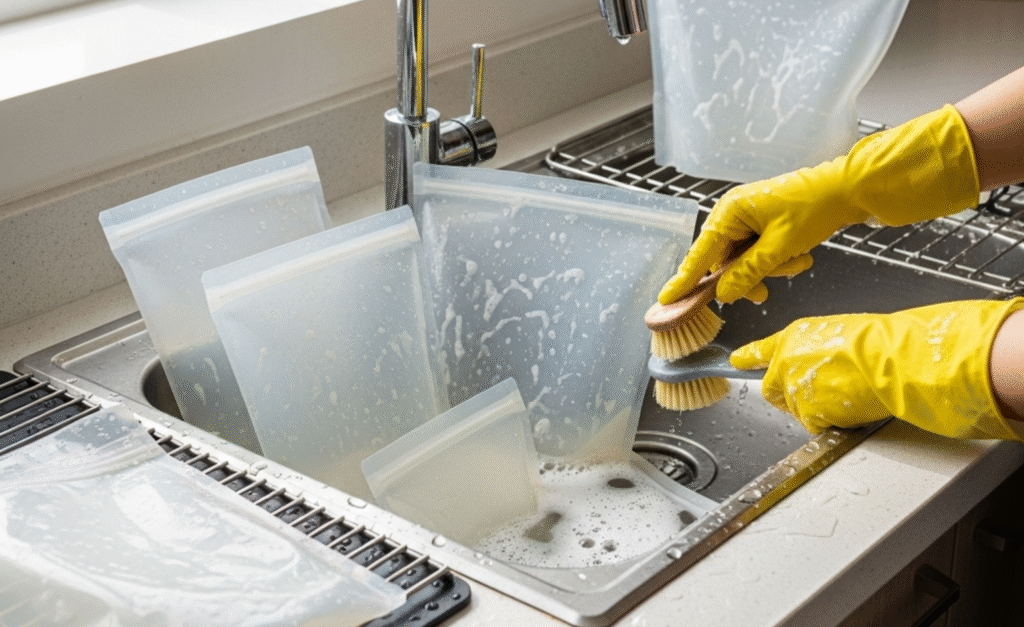Introduction
Do you often find yourself frustrated with piles of single-use plastic bags in your kitchen? They are cheap and convenient, but they create waste and pose health risks. Glass and metal containers are safe, but they are heavy and inconvenient to carry around. That’s where silicone bags come in.
Silicone bags are reusable, durable, and safe for food storage. They can withstand both freezing and heating, which makes them suitable for everything from storing leftovers in the freezer to cooking meals in boiling water. In this guide, we’ll take a deep dive into what silicone bags are, why they matter, how to use them, and how to choose the right ones. By the end, you’ll know why silicone bags are one of the smartest eco-friendly swaps you can make in your daily life.

What Are Silicone Bags?
Silicone bags are reusable storage bags made from food-grade silicone. Silicone is a polymer derived from natural silica, or quartz sand. It is flexible, non-toxic, and resistant to extreme temperatures.
Unlike disposable plastic bags, silicone bags don’t release harmful chemicals when exposed to heat or cold. Compared to glass containers, they are lightweight and unbreakable. Unlike metal containers, they are soft, foldable, and semi-transparent, making it easy to see what’s inside.
Why Choose Silicone Bags Over Plastic Bags?
Most people start using silicone bags for environmental reasons, but their benefits go far beyond that.
Eco-friendly: One silicone bag can replace hundreds of single-use plastic bags, significantly reducing waste.
Safe and non-toxic: Food-grade silicone contains no BPA, phthalates, or other harmful chemicals.
Heat and cold resistant: Works safely from -40°C to 230°C (-40°F to 446°F). Freezer, microwave, and boiling water safe.
Strong seal: Many silicone bags feature airtight zip closures or sliders to prevent leaks.
Portable and flexible: They fold easily, saving space in the kitchen or on the go.
In short, silicone bags are a long-term investment in both health and sustainability.
Related Reading: How to Choose High-Quality Silicone Bags? A Complete Buying Guide

Common Uses of Silicone Bags
Silicone bags are incredibly versatile, making them useful in countless situations.
Food storage: Perfect for fruits, vegetables, bread, snacks, nuts, and even raw meat.
Freezer storage: Great for storing soups, sauces, leftovers, or portioned meat.
Cooking: Safe for sous vide cooking, microwaving meals, or even short oven use.
On-the-go use: Ideal as lunch bags, snack packs, or travel organizers for picnics and camping.
Non-food storage: Useful for cosmetics, baby food, pet snacks, charging cables, or other small items.
A silicone bag is more than a food container—it’s a multi-purpose everyday tool.
Are Silicone Bags Safe?
Safety is the number one concern for most people, and the answer is yes—silicone bags are safe.
Material safety: Food-grade silicone is widely used in baby products like pacifiers and in medical equipment, proving its safety.
Certifications: Quality products usually comply with FDA or LFGB food safety standards.
Usage tips: Avoid direct contact with open flames or sharp objects. Do not expose to extreme high heat above 200°C (392°F) for long periods. Wash thoroughly before first use.
Compared to plastic bags, silicone bags are a much safer and healthier option.
How to Clean and Maintain Silicone Bags
Proper cleaning and care extend the life of your silicone bags and keep them odor-free.
Cleaning methods: Dishwasher-safe, or wash by hand with warm water and mild soap.
Removing odors: Soak in baking soda solution overnight, or rinse with lemon juice or vinegar.
Drying tips: Place the bag upside down on a cup or rack to allow airflow and prevent mold.
Extra care: Avoid storing sharp bones or shells that may scratch the surface. Check the sealing strip regularly for wear.
With the right care, a silicone bag can last for two to three years or even longer.

Silicone Bags vs. Other Storage Options
| Feature | Silicone Bags | Glass Containers | Plastic Bags | Metal Containers |
|---|---|---|---|---|
| Weight | Lightweight, flexible | Heavy, breakable | Very light | Medium to heavy |
| Safety | High, BPA-free | High, non-toxic | May contain toxins | High, but heats fast |
| Temperature | -40°C to 230°C | -20°C to 200°C | -10°C to 80°C | High, not transparent |
| Eco-Friendly | Reusable, long life | Long-lasting | Disposable, polluting | Long-lasting |
| Portability | Foldable, space-saving | Bulky, not portable | Convenient but weak | Not ideal for travel |
Clearly, silicone bags combine the best of portability, safety, and eco-friendliness.
Buying Guide: What to Look for in a Silicone Bag
Not all silicone bags are created equal. Here’s what to check when buying.
Material: Ensure it is 100% food-grade silicone with no fillers.
Thickness: Thicker bags are more durable and leak-proof.
Seal design: Zipper or slider seals provide better protection.
Size options: Small (snacks), medium (lunch), large (freezer storage).
Certifications: Look for FDA or LFGB approval for food safety.
Pros and Cons of Silicone Bags
Pros:
- Environmentally friendly and sustainable
- Safe and non-toxic
- Heat and cold resistant
- Lightweight and portable
- Multi-purpose use
Cons:
- More expensive than disposable plastic bags
- Higher upfront cost
- May retain food odors over time
Despite these minor drawbacks, silicone bags remain one of the most cost-effective options in the long run.
Frequently Asked Questions (FAQ)
- Do silicone bags smell?
New bags may have a slight odor, but it goes away after a few washes. - Can I use them in the microwave or oven?
Yes, but keep temperatures under 200°C (392°F) and avoid direct flame. - Can I store oily or greasy food?
Yes, but wash and dry promptly to prevent stains or odors. - How long does one silicone bag last?
With proper care, they can last two to three years or more. - Are silicone bags recyclable?
Yes, silicone is recyclable, but local recycling programs may vary.
Conclusion
Silicone bags are more than just an eco-friendly alternative to plastic. They are a practical, safe, and durable solution for modern households. From storing fresh produce to cooking sous vide, they adapt to countless needs while helping reduce waste.
Switching to silicone bags is not only a choice for convenience—it’s also a choice for better health and a cleaner planet. If you want a storage solution that combines sustainability, safety, and long-term value, silicone bags are absolutely worth it.